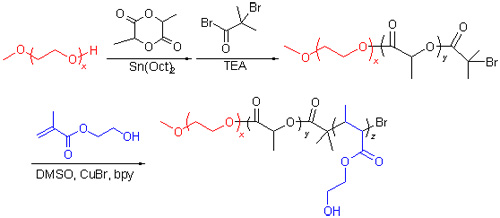[1] (a) Lipinski, C. A. J. Pharmacol. Toxicol. Methods 2000, 44, 235.
(b) Lipinski, C. A.; Lombardo, F.; Dominy, B. W.; Feeney, P. J. Adv. Drug Delivery Rev. 2001, 46, 3.[2] Kwon, G. S. Colloids Surf., B 1994, 2, 429.[3] Kataoka, K.; Harada, A.; Nagasaki, Y. Adv. Drug Delivery Rev. 2001, 47, 113.[4] Wei, H.; Cheng, S. X.; Zhang, X. Z.; Zhuo, R. X. Prog. Polym. Sci. 2009, 34, 893.[5] Kwon, G. S. Crit. Rev. Ther. Drug Carrier Syst. 2003, 20, 357.[6] Li, S. D.; Huang, L. Mol. Pharm. 2008, 5, 496.[7] Amado, E.; Augsten, C.; Mäder, K.; Blume, A.; Kressler, J. Macromolecules 2006, 39, 9486.[8] Feil, H.; Bae, Y. H.; Feijen, J.; Kim, S. W. Macromolecules 1993, 26, 2496.[9] Noga, D. E.; Petrie, T. A.; Kumar, A.; Weck, M.; García, A. J.; Collard, D. M. Biomacromolecules 2008, 9, 2056.[10] Ru, M. L.; Dai, W. F.; Du, Z. Z.; Lang, M. D. Acta Chim. Sinica 2008, 66, 1884 (in Chinese).
(茹敏良, 戴炜枫, 杜征臻, 郎美东, 化学学报, 2008, 66, 1884.)[11] Jakubowski, W.; Lutz, J. F.; Slomkowski, S.; Matyjaszewski, K. J. Polym. Sci., Part A: Polym. Chem. 2005, 43, 1498.[12] Schappacher, M.; Fur, N.; Guillaume, S. M. Macromolecules 2007, 40, 8887.[13] Jakubowski, W.; Matyjaszewski, K. Macromol. Symp. 2006, 240, 213.[14] Vert, M.; Li, S. M.; Spenlehauer, G.; Guerin, P. J. Mater. Sci.: Mater. Med. 1992, 3, 432.[15] Prasitsilp, M.; Siriwittayakorn, T.; Molloy, R.; Suebsanit, N.; Siriwittayakorn, P.; Veeranondha, S. J. Mater. Sci.: Mater. Med. 2003, 14, 595.Wang, B.; Pan, J.; L, Y.; Mi, L.; Zhang, T. X. Acta Chim. Sinica 2008, 66, 487 (in Chinese).
(王彬, 潘君, 刘颖, 糜丽, 张廷秀, 化学学报, 2008, 66, 487). |
